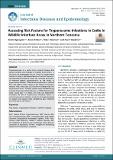| dc.contributor.author | Ngongolo, Kelvin | |
| dc.contributor.author | Estes, Anna | |
| dc.contributor.author | Hudson, Peter | |
| dc.contributor.author | Gwakisa, Paul | |
| dc.date.accessioned | 2021-02-10T08:53:53Z | |
| dc.date.available | 2021-02-10T08:53:53Z | |
| dc.date.issued | 2019-05-04 | |
| dc.identifier.issn | 2474-3658 | |
| dc.identifier.uri | https://doi.org/10.23937/2474-3658/1510078 | |
| dc.identifier.uri | https://dspace.nm-aist.ac.tz/handle/20.500.12479/1105 | |
| dc.description | This research article published by the Journal of Infectious Diseases and Epidemiology, 2019 | en_US |
| dc.description.abstract | Trypanosomosis is a vector-borne, tropical disease that causes mortality and morbidity in livestock and humans. In this study we investigated the risk factors for trypanosome infection in cattle in the Maasai Steppe of northern Tanzania. We assessed the influence of age, sex, herd size and history of treatment against trypanosomosis as risk factors of trypanosome infection. Cattle blood samples were collected from 150 cattle in three villages in the vicinity of Tarangire National Park, which acts as a reservoir of tsetse flies, the trypanosome vector. Parasite species were identified using a nested Polymerase Chain Reaction (n-PCR). Smaller herd sizes, young age (1-2 years), and male sex significantly increased the risk of trypanosome infections. Efforts to control trypanosome infection should be strategically based on location and season while considering age, treatment and herd size as risk factors. | en_US |
| dc.language.iso | en | en_US |
| dc.publisher | Journal of Infectious Diseases and Epidemiology | en_US |
| dc.subject | Trypanosome infection | en_US |
| dc.title | Assessing Risk Factors for Trypanosome Infections in Cattle in Wildlife Interface Areas in Northern Tanzania | en_US |
| dc.type | Article | en_US |

